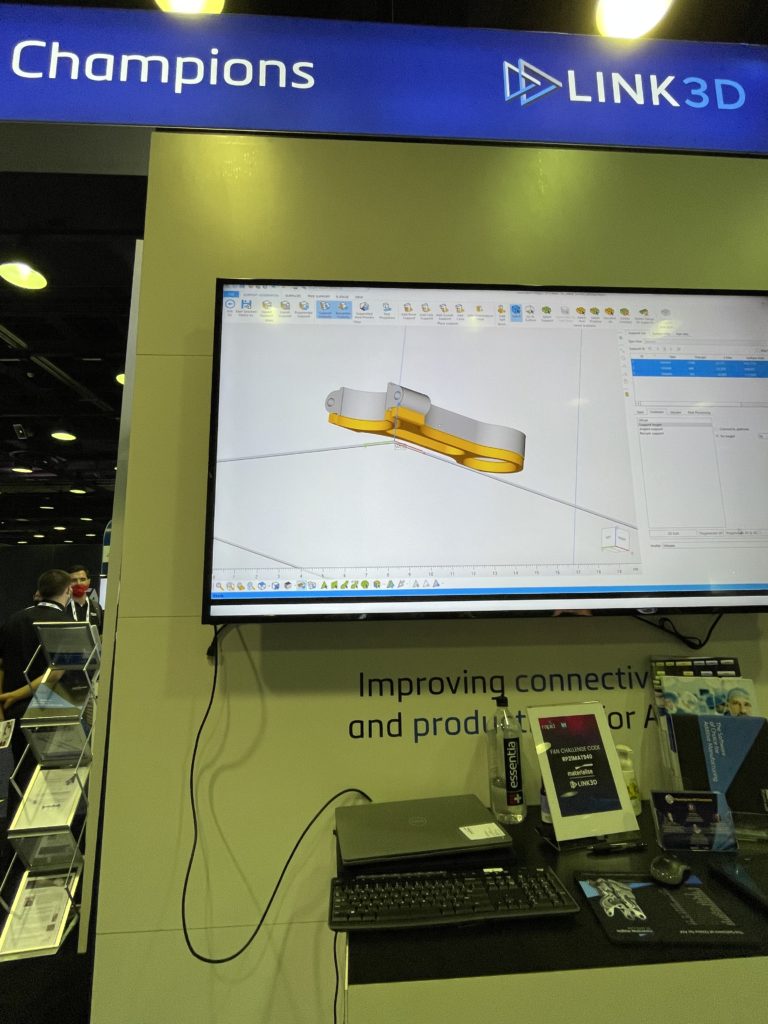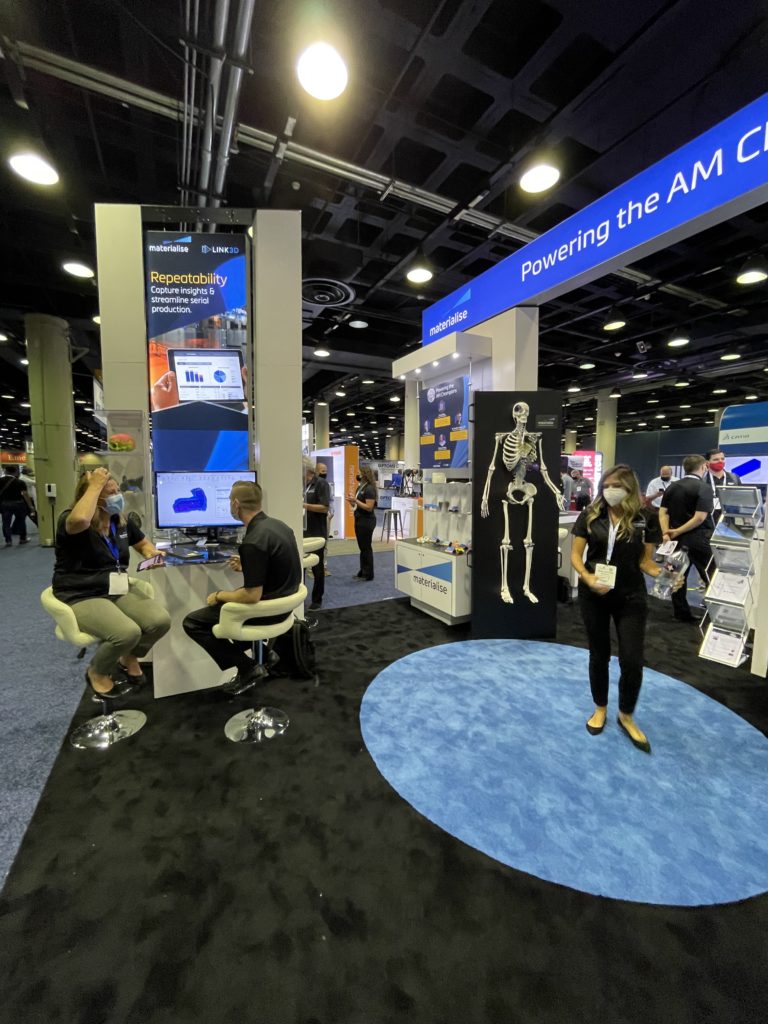While attending RAPID + TCT a few weeks ago, I sat down with Bryan Crutchfield, the Vice President and General Manager – North America at Materialise (NASDAQ: MTLS), to discuss what’s new with the Belgian 3D printing service and software company. Of course, the first topic that came up was obviously the company’s option to acquire Link3D, which was announced in April.
“During the pandemic, we took an option to buy Link3D, and we intend to complete that transaction by the end of the year,” he told me.
The integration has already begun, and Link3D will be directly connected to Materialise Magics, which will let users work more efficiently with the file management software and Link3D’s Manufacturing Execution System (MES). The goal of the acquisition is to bring the power of the company’s software suite directly to the cloud.
“We spent the last few years breaking apart all of our tools, and redesigning them so they can go up to the cloud,” Crutchfield said, explaining that this will make it possible to stitch together a digital workflow.
“That’s the next thing for 3D printing,” he continued, “serialized production with a specific workflow, very tightly controlled and automated.”
When you automate manufacturing tasks, less human errors are created, and Crutchfield said that’s why it’s so important to do as much as much as possible automatically. In addition, automated tasks make it possible to capture the data during the process and begin creating feedback loops. He told me that Materialise has been working on this “behind the scenes” over the last few years, which is why the purchase of Link3D was such a good match for the company.
“So we’re going to be enabling this digital manufacturing platform to allow our users to better tailor their workflows to their specific needs, industry, and products,” Crutchfield said. “I think it’s something the industry has been looking forward to for a long time, rather than trying to piece together a lot of different software packages.”
He called it the slow revolution, this continuing march towards a unified 3D software platform.
“It will happen, but it’s taking a while still. With so many different technologies, they’re all going to have their applications and uses, it’s not going to just happen,” he told me. “So for us, staying agnostic and open, and collaborating with as many open systems as we can and helping to connect everyone together, is where we’ll continue to play.”
Crutchfield said that in early 2022, Materialise plans to launch a connected version of its tools and products with Link3D.
“That’s mission one, our customers are begging for that,” he said. “We’ll later try to bring out an even larger suit of tools.”
He explained that the company has had to redesign its entire product line, but that the eventual goal is to make everything API-enabled in order to stitch all the tools together “in unique ways.” In the future, Materialise may get more into MES and scheduling, which is Link3D’s area of expertise, and work to create automated, certified workflows.
“The industries that are successful right now are certified, like medical and aerospace,” Crutchfield explained. “They need to lock down those workflows and capture the data, because you’ve got requirements from the government to store that data for many years.”
He explained how 3D technology lends itself especially well in the medical field because “every person is unique,” and due to the fact that reimbursement is moving to outcome-based.
“There’s a real incentive to make sure everything is done correctly the first time,” he said. “In the medical sector, they’ve seen that 3D printing can help with tailoring the treatment to a specific patient.”
Crutchfield mentioned how rewarding it is to see how life-changing these technologies can be in the medical field, and I absolutely agree with him.
“It would have been impossible a few years ago, but now it’s right in our wheelhouse,” he said. “We believe in making the world a better place.
“Obviously it started pretty naturally with orthopedics, but we’re starting to move into soft tissues and pulmonary, and our R&D team is figuring out what we can and don’t do.”
Asking itself how to make its medical workflows better and more accurate, Materialise has been expanding its Mimics tools, taking the technology and “breaking it apart and arranging it very specifically into modules,” as Crutchfield explained. The company has been partnering with some of the larger US hospitals, such as Mayo Clinic, which use Mimics software on a regular basis.
“There’s a lot that hospitals have to think about when they’re starting out,” he said about 3D printing adoption. “So we’re trying to structure the software to enable them to do this seamlessly right from the beginning.”
Another initiative that Materialise has been pushing is sustainability, which is one of the company’s five-year objectives. As one step in the right direction they joined the AMGTA this spring, but Crutchfield says they believe there’s still a lot of work everyone in the industry can do to become more sustainable.
“The more efficient we become, the more costs will go down,” he said. “But also, take traditional manufacturing methods. 3D printing is dirtier than molding, so we as an industry need to address that, and how to stop throwing out powder. We’re really pushing to help the industry drive that forward.”
Crutchfield said the company has signed onto the UN’s initiative pledge for sustainable development goals in an another effort to reduce its carbon footprint.
“We’re reporting every year how we’re progressing to those goals,” he said. “We’re moving to green electricity in our North American plants, we’re looking at powder recyclability, and traveling.”
The pandemic did give everyone the (unasked for) opportunity to take a step back from work travel, and people have had to get creative with virtual events in the last two years. So many industry companies, like Materialise, have used the opportunity to take a hard look at how much they travel, and how much is actually necessary.
“COVID helped make us more mindful of that, that our employees traveled a lot,” Crutchfield said.
Take a look at some more of my pictures from the Materialise booth, and stay tuned for more news from the RAPID 2021 show floor!
Subscribe to Our Email Newsletter
Stay up-to-date on all the latest news from the 3D printing industry and receive information and offers from third party vendors.
Print Services
Upload your 3D Models and get them printed quickly and efficiently.
You May Also Like
3D Printing News Briefs, July 2, 2025: Copper Alloys, Defense Manufacturing, & More
We’re starting off with metals in today’s 3D Printing News Briefs, as Farsoon has unveiled a large-scale AM solution for copper alloys, and Meltio used its wire-laser metal solution to...
3DPOD 260: John Hart on VulcanForms, MIT, Desktop Metal and More
John Hart is a Professor at MIT; he´s also the director of the Laboratory for Manufacturing and Productivity as well as the director of the Center for Advanced Production Technologies....
3D Printing News Briefs, June 28, 2025: Defense Accelerator, Surgical Models, & More
In this weekend’s 3D Printing News Briefs, 3YOURMIND was selected to join an EU Defense Accelerator, and PTC has announced model-based definition (MBD) capabilities within Onshape. Finally, a study out...
EOS in India: AM’s Rising Star
EOS is doubling down on India. With a growing base of aerospace startups, new government policies, and a massive engineering workforce, India is quickly becoming one of the most important...












































